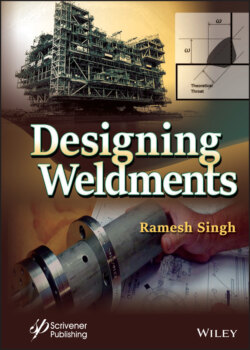Читать книгу Designing Weldments - Группа авторов - Страница 24
2.1.3.4 Fatigue Strength
ОглавлениеWhen a metal structure is subject to repeat (a cyclic load) loading, the metal is subject to specifically more stringent conditions. The cyclic loading fatigues the metal structure and reduces the life of the structure, and ultimately fractures and fail. Fatigue strength is an important mechanical property to know about the metal and welds if cyclic loading is one of the demands of the designed structure. Metal’s ability to sustain cyclic loading, for longer time of its design life is the Fatigue strength of that metal. Fatigue strength is a measures of load versus the time.
The fatigue fracture develops as each successive applied load advances the tip of the crack further to a point where the metal has no more ability to resist fracture. This type of crack progression is called stable growth of the crack. The rate of advance of the crack increases with the time and applied load, and the growth becomes unstable, and sudden failure occurs. It is important to know that any crack growth can occur only under cyclic loading in combination with residual tensile stresses in the metal itself, if there is a compressive stress, at the crack tip the crack growth will stop.
The stress that the metal can endure without fracture successively decreases as the number of cycles increases. Each successive stress cycle reduces the metal’s ability to sustain further.
For steel the fatigue strength is almost constant beyond about two million cycles. Several million more cycles are needed for steel to cause reduction in steel’s fatigue strength. Therefore, the Fatigue Limit becomes maximum stress or a range of stress which metal will be able to bear for infinite number of cycles without fracture, this is called the Endurance Limit. This leads us to the definition of the Fatigue Life. Fatigue life is the number of cycles of stress that the metal can sustain in the stipulated conditions.
Several tables are published that list various metal’s endurance limits. These are developed using a polished round test bars that are tested in air. These values may be useful in certain calculations for parent metal that may closely meet the test conditions. However, these endurance-limit values are not applicable to welds, and weld and metals that are in service in very specific environment. One of them very specific to welds is that welds have very abrupt changes in cross section, geometry, and also metallurgical make up, HAZ that has coarse grains, is one of them. Also welds contain some very specific discontinuities for example lack of fusion, lack of penetration, undercuts, etc., that is not found in the parent metal.
The life cycle of a welded structure is dependent on the welds that it contains. And the number of repeated variations of tensile or alternating between the tensile and compressive stresses that the weld goes through. These stresses are initially within the elastic range, and as long as it remains within that elastic range the structure is deemed safe, however if there are any stress concentrating anomaly in the weld (or even in the structure itself) will change that equilibrium, and subsequently and over the time they transfer to plastic stage and that leads to eventual failure through that weld and structure anomaly. When we say the structural detail or weld geometry, we include aspects like, type of joint, type of weld, surface finish, and structural details, all these are capable of amplifying the stress to the tip of the mechanical notches.
When designing welded built-up members, or welded connections for fatigue loading, the local codes and standards must be followed for its safe operation. In the absence of such guidance of code and standards full finite element analysis should be conducted for the design to be safe. Structural construction contain significant amount of residual stress, these residual stress are enhanced in a welded structure. It is understood that residual stress themselves do not cycle and cause fatigue stress, but they augment or detract from applied stress. The augmentation or detraction is dependent on the signs (positive or negative) of the residual stress. What we derive from the just preceding is statement? That we can reduce the impact of the residual stress y inducing compressive stresses, and that can be achieved by either or a combination of following
1 (1) Welding in sequence,
2 (2) Localized heat treatment
Both the above methods can develop compressive stress on welds, reducing or at least not augment the effect of cyclic loading.
